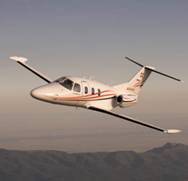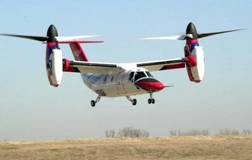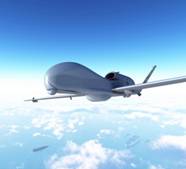- aviation infrastructure systems performance and modernization
- integration of new aviation technologies
- service availability, capacity and effectiveness of airports and air traffic control systems and
- cost-effective modernization.
Dr. Rakas is the author or co-author of over 100 papers, publications, and technical reports that have been cited many times and used in high-level research in the United States and worldwide. She has collaborated with other renowned aviation experts, authoring papers and participating in over 200 high-level presentations and worldwide discussions through conferences, symposia, workshops, talks, panels or session chairmanships.
List of Research Topics (selected):
Impact of New Aviation Vehicles on NextGen's Performance, Safety, and Environment
Impact of New Aviation Vehicles on NextGen's Performance, Safety, and Environment; sponsor: Sensis/NASA
(with Matthieu Dupont)

NASA is conducting an important number of research projects in the different areas of interest of Next Generation Air Transportation system (NextGen). One of the research areas still largely unexplored is the interaction between NextGen and the new types of aircraft that are currently being at different stages of development and that are expected to be operational by 2025.
This research is focused on analyzing the impact of five new vehicles on NextGen in the performance, safety, and environment domains, in the 2025-2040 time period. The vehicles are Very Light Jets (VLJ), Cruise Efficient Short Take-Off and Landing (CESTOL), Civil Tiltrotor (CTR), Unmanned Aerial Systems (UAS), and a 100-passenger SST.
New Vehicles
|
Source: NASA, Very Light Jet (VLJ) |
Source: NASA Conceptual HWB CESTOL - "The Zuk Flyer" (from AIAA-2009-1133 " Performance Challenges of Hybrid Wing CESTOL Transports" C. Hange, NASA, Moffett Field, CA) |
|
Source: Bell Agusta Civil Tiltrotor |
Source: Northrop Grumman, Unmanned Aerial Systems (UAS |
|
Source: NASA, 100-passenger SST |
The goal of this research project is to develop arrival/departure procedures for both conventional traffic and the five new vehicles in the San Francisco Bay Area metroplex. The procedures are designed in compliance with the NextGen Concept of Operations (CONOPS), so that all aircraft are flying under RNP 0.3, with closely-spaced parallel runway operations allowed and Continuous Descent Approaches a standard. Some of the new vehicles can exploit their performance characteristics to handle new kind of approaches. Steep approaches, vertical approaches with the CTR, and spiral approaches with the CESTOL are among those unconventional procedures.
The two following figures are 3D representations in Google Earth of the procedures. On the left is the case of the Southeast plan with departures in pink and arrivals in purple. On the right the case of the West plan, which occurs most of the time in the bay area, with arrivals in yellow and departures in blue.
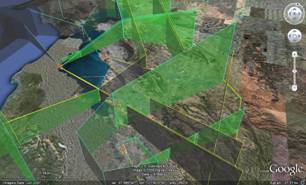
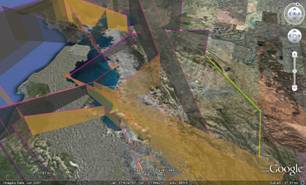
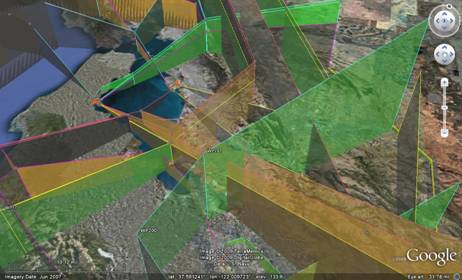
The figure above represents all the procedures, without considering the active plan of operations.
Wake Turbulence Research in the Next Generation Air Transportation (NextGen) Environment
Wake Turbulence Research; sponsor: FAA
(with Brian Woflman)
This research is a response to the FAA's need to examine a methodology for increasing runway capacity adding super-density airport and trajectory-based operations. The purpose of this research is to understand the constraint wake turbulence places on any concept which proposes reduced aircraft separations. This research is divided into four interrelated tasks:
Task 1 involves examining the NextGen Concept of Operations and determining which parts of the concept would cause an increased risk of an aircraft encountering a wake turbulence hazard. The NEXTOR universities performed detailed investigations of sub-elements of the Nextgen system including network-enabled information systems, performance-based operations and services, weather assimilated into decision-making, layered adapted security, positioning, navigation and timing services, aircraft trajectory-based operations, equivalent visual operations, and super-density departure and arrival operations to determine elements of the system with higher incidents of wake turbulence hazards under Nextgen.
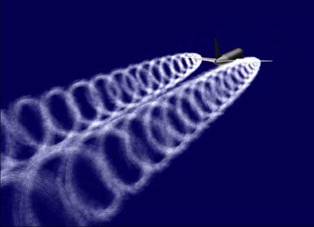
Task 2 involves research questions, mitigations and prioritizations of wake hazards for the purpose of validating and prioritizing wake hazard causes related to the issues in Nextgen's Concept of Operations. Specific outcomes for this task include mitigations and controls likely to reduce the risk of wake hazard, data needs and required experiments to address research questions, prioritizing the most significant hazard causes, and indentifying Nextgen and baseline scenarios to be studied in subsequent tasks. A goal of high importance is to determine the most critical hazard causes, research issues and develop a research plan for analyzing these causes and issues in later tasks.
Task 3 involves developing a model of current operations to use as a baseline in studies of future Nextgen era operations. The desired outcome is an estimate for current NAS operational scenarios and associated wake encounter causes and frequency of those causes. Ultimately, the aim is to form a relative comparison between proposed Nextgen operating concepts and existing baseline operations.
Task 4 involves assessing relative wake turbulence encounter probability associated with Nextgen scenarios. Results should include a relative analysis comparing wake encounter probabilities between the NextGen and baseline scenarios. The approach is to build a model of aircraft locations while using data from existing flight tracks as building blocks.
Impact of Convective Weather on National Airspace Systems (NAS) Performance
Impact of Convective Weather on National Airspace Systems (NAS) Performance; sponsor: FAA
(with Aurelian Vidal)
The purpose of this study is toexplore the impact of lightning strikes on the National airspace System (NAS) performance and provide the management information necessary to guard critical NAS infrastructure against lightning strikes.
The research is based on two exhaustive sets of data. The first one represents millions of lightning strikes measured by the National Lightning Detection Network (NLDN) between 1999 and 2006. The other is the list of all outages that occurred in the NAS during the same period.
In the first step, the data are used for constructing a statistical model. This model, by using lightning strikes characteristics that occurred in a given area and period of time, will determine the probability that an outage is caused by convective weather. The major issue is the understanding of the outage mechanism. Because no such studies have been carried on before, all possibilities have to be analyzed, taking into account the very high randomness in the lightning strike phenomenon.
Once the model is refined, it will be capable of processing all the outages data and thus determining the proportion of lightning strikes-caused outages. The expected results will enable better understanding of the general patterns of those failures, such as the type and the location of the systems. With this output, we will be able to determine the current impact of lightning strikes on NAS and then estimate the effects in terms of capacity, safety or delays.
Finally, the two previous parts will be combined to create a sound business investment model. By knowing precisely the effect of lightning strikes on NAS, we can find the benefits brought by the enhancement of the protection of given equipment. Therefore, we can determine the optimal budget that should be allocated to efficiently reduce the effect of convective weather on National Airspace Systems performance.

NB: "Correlated lightning strikes" are strikes that occurred in a given vicinity of an outage and in a determined period of time before this outage.

In this graph, each column corresponds to one outage and each blue dot represents a correlated lightning strike. Distance does not appear in the graph.
Environmental Performance Assessment in Enhancing the Sustainability of Airport Developments
Environmental Performance Assessment in Enhancing the Sustainability of Airport Developments
(with Jean-Christophe Fann)
Civil aviation has an increasingly important role in the social and economic developments of cities and regions. Airports connect regions to the rest of the World and symbolize their integration in a global market. As major transport infrastructure facilities, they are significant sources of pollution and a major concentration of energy usage. They are also cultural, social, economic and commercial points of exchange.
Meeting the strong and growing demand in commercial aviation provides strong benefits for airport authorities but also causes significant environmental costs. The impact of airport infrastructure on the environment, i.e. climate change, noise, water and air quality, is likely to grow and to threaten airport growth. In this perspective, the challenge for airport designers is to enable social and economic development in a sustainable manner.
Airports worldwide are currently taking individual initiatives in an attempt to reduce their environmental footprint. However, little knowledge exists to understand which actions and measures are more relevant to this aim and which airports perform best from a sustainability point of view. As the sensitivity to environmental standards increases, airports have now started to acknowledge the potential for benchmarking against other airports to improve their competitive position through the identification of best practice.
The purpose of this research is to develop a framework for assessing and benchmarking the sustainability of airport systems. Environmental benchmarking is an important tool to measure an airport's performance and assure that it is on track when it comes to environmental excellence. The results can assist airport managers in sharing successful initiatives in the integration of environmental programs into airport operations.
First, existing methods and procedures in the field of environmental impact assessment and airports sustainability are reviewed and considered for benchmarking purposes. Such methods are: traditional environmental impact assessment, life‐cycle assessment of airport infrastructure, generic green building certification standards, concept of environmental capacity, etc. In a second step, environmental performance criteria (EPI) from the methods analyzed in the first step are reviewed to determine their relevance for environmental benchmarking. Once this preparatory work is complete, the study will use multi‐criteria decision making tools to compare assessment methods and types of initiatives applicable to the aviation industry. The overall goal is to determine what best practice could be in the field of environmental benchmarking.
Robust Optimization Models for Aviation Infrastructure Investments
Robust Optimization Models for Aviation Infrastructure Investments
In this research we develop a robust investment strategy for National Airspace System (NAS) infrastructure at a single airport.
Lightning poses a significant hazard to NAS terminal airspace operations. Lightning strikes can disable key NAS equipment and reduce airport capacity. In response, an infrastructure investment model is formulated specifically to make terminal airspace performance more robust against lightning strikes. This investment model includes several new contributions to the aviation literature. The first is to model airport capacity and traffic management as a network utility maximization problem. The rich literature on network utility maximization and traffic management, highly developed in the context of wireless networks, shares many parallels with airport operations. The second contribution is to incorporate a second degree stochastic dominance constraint into a convex optimization problem. Second degree stochastic dominance is well studied in the literature. In this case, the dominance constraint is on capacity. The third contribution of this work is an efficient decomposition based method that solves the dominance constrained resource and traffic management program. This research begins with a literature review and then introduces the model for airport capacity and the dominance constrained investment problem. In the next step we address the dual of the problem and present a solution method based on duality decomposition. Two alternative optimization strategies are introduced and numerical experiments are conducted to compare all three approaches side-by-side. We also raise the question of model misspecification and discuss ideas about future research.
Impacts of a Mixed Media Air Traffic Control Communication Environment on Aviation Efficiency
Impacts of a Mixed Media Air Traffic Control Communication Environment on Aviation Efficiency; sponsor: FAA
(with Sarah Yenson)
This study is a response to capacity constraints in the National Airspace System (NAS), and in particular, to the use of radio frequencies associated with en route sectors.
More traffic and less available radio frequency time translate to a higher workload for a sector's controller. When controllers encounter potential conflicts during a period of high workload, greater distances may be assigned to ensure separation, or controllers may, due to workload, be unable to re-vector aircraft as quickly as they would during periods of lesser workload. The introduction of the Next Generation Air Transportation System (NextGen) has potential to decrease controller workload through the introduction of data communications enhancements. These data communications enhancements will remove selected pilot-controller communications from the voice frequencies to a text-based data transfer environment known as datalink.
Actual vs. Planned Route
|
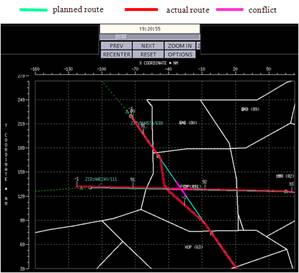
|
The introduction of datalink to the Air Traffic Control (ATC) system will occur in stages. The first stage, Segment 1, includes four dimensional trajectory management, communications management, enroute clearances, and ground-issued clearances and taxi instructions. This segment aims to provide these services to en route and tower flight control environments. Segment 2 increases the data communications capabilities somewhat, by adding further 4D trajectory agreements, enroute 4D trajectory clearances, and information on status, delay, and constraints within the NAS. Segment 2 also is concerned with expanding the use of Segment 1's services to include terminal control areas. Segment 3, which does not affect this study, expands the use of data communications technologies to widespread 4D trajectory use, widespread separation minimums, and zero-visibility taxi guidance..
In this study, the main concern is the use of data communications during enroute phases of flight. The majority of communications that this study addresses are dealt with during Segment 1. Communication types that are deemed non-critical for this case are handoffs, check-ins, altimeter readings, and speed, altitude, heading, and route clearances, as well as the appropriate responses to these communications.
Previous studies investigating the use of datalink in the ATC environment have demonstrated that datalink message transfer times are greater than the transfer times related to voice communications. These longer times are due to delays in message communication caused by technological limitations; however, as datalink becomes more widely used in the ATC environment, further advances in data transfer times will be developed and the latency issues associated with datalink will be lessened (3). Another factor in datalink's lengthier communication times is the time required for message composition. Composition in a text-based environment requires more time because of the message's manual entry.
However, the increased transmission time for datalink communications does not pose a significant problem for ATC communications. In Segment 1, messages sent via datalink will be non-critical messages, so time is not a crucial part of these communications. By sending these non-critical messages over datalink, the voice frequencies will be more available to deal with more crucial communications. Additionally, a portion of the messages sent via datalink are routine communications such as handoffs and check-ins. Controllers' messages associated with these routine events may be automated, allowing them to merely press a button to acknowledge or send a message, thus reducing the time spent in message composition.
The significance of this work is in providing an indication of benefits that can be gained by implementing the use of data communications in the air traffic control environment. A decrease in the workload of en route air traffic controllers could lead to a decrease in controller-assigned deviations from flight paths, leading to an increase in aspects of the air traffic control system.
Workload Input Interdependencies
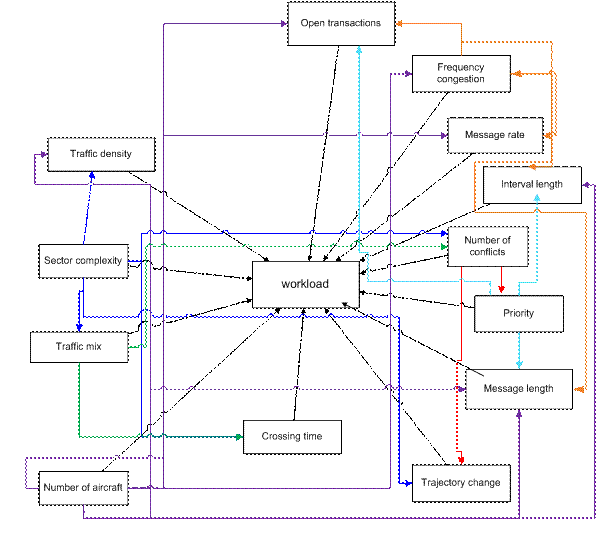
The proposed methodology takes the following steps: 1) determine inputs for a voice-only workload model; 2) determine a relationship between voice-only data and mixed-media data; 3) formulate a relationship between selected inputs and the vector distances flown; and 4) calculate potential reductions in controller workload and vector distances assigned for a mixed-media environment.
This research demonstrates increased efficiency with the use of a mixed-media environment, as increasing efficiency in the air traffic system would have wide reaching impacts in many aspects of the aviation community, including economic, environmental, and customer service arenas.



